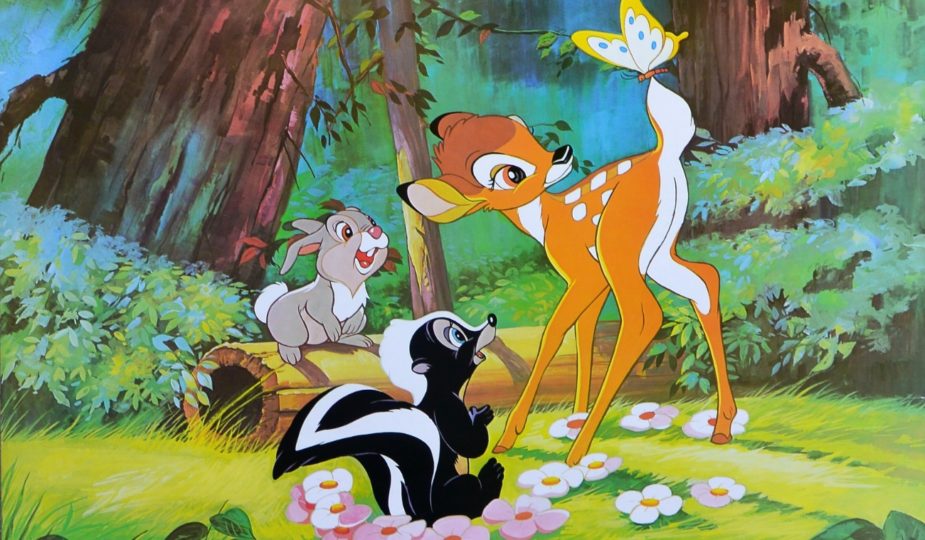
Hall of Shame – Bambi (1942)
The now cryogenized Walt Disney, awaiting his resurrection at minus 180 degrees Celsius, conceived and realized a deep-frozen infantile world full of regressive imaginations and phantasms through his movies. Movies that taught especially American society on how to notoriously sugar-coat, and which established an entire unhealthy system of values and ideals, mostly beauty ideals that gave birth to Barbie & co. Having grown up reading the original dark and gloomy Grimm fairy tales in German, it blew my mind to see what happened to them after being disney-fied: in Hollywood these stories were shallow and shiny shadows of themselves, deprived of all meaningful ambiguity and danger; the hard Teutonic faces transformed into button-eyed caricatures with full, red cheeks.
Just like in the Grimm’s fairytales, there is something dark and sinister lurking beneath the surface of many mind-numbing Disney films, but the darkness here has a different quality that eludes analysis. It rather seems to be a simulation of something dark and sinister which cannot be explained or understood but is simply there to be swallowed. Much has been written about Walt Disney and his eccentric trademark of smuggling sex references and dick jokes into his supposedly innocent children’s and family movies. It’s there, and a brief google search quickly exhausts curiosity without having to invest too much time into the topic or the movies itself. Now, let’s focus on one particular film, Bambi, and the only question this work arises for me: Why did Walt Disney decide to make a movie out of a book whose author also penned one of the most scandalous and censored books ever written, one that glorified child pornography, rape, and incest?
Felix Salten, born as Zsiga Salzmann in 1869, was a Jewish-Viennese author who was also labeled the “deer-sodomite” by his former roommate Karl Kraus after the publication of Bambi in 1923. Josephine Mutzenbacher or The Story of a Viennese Whore, as Told by Herself was published in 1906, and although Salten never admitted to authorship, text-analysis ultimately proved that he is the author of the depraved pornographic book (also under suspicion was Arthur Schnitzler, a friend of Salten and author of Dream Story, which inspired Kubrick‘s Eyes Wide Shut). In the book, the aging Viennese whore Josephine recalls her life as a child until (not from) the age of 13- a life that consists of sexual encounters and nothing else, with the heavy sexual activity starting around the age of 5. Now, don’t make the mistake to assume that the book is Josephine’s confession of pain and suffering. No. Page after page we read about how she and all the other children around her want sex, enjoy sex – precisely statutory rape and child prostitution- and how they actively seduce each other and adults. Josephine is like an emotionless robot programmed on sex, and so she enjoys having sex with the children around her, her teachers, neighbors, the pastor, and every other old man. Incest barriers are torn down early on, and Josephine joyfully shares the bed with her brother and more so her father. The little boys around her enjoy their mothers.
Banned in many countries including liberal Germany (after all home of Magma Porn et al.) Josephine Mutzenbacher was at the center of a seminal ruling of the Federal Constitutional Court of Germany in 1990, now referred to as ‘The Mutzenbacher Decision’: it maintained that the book by Bambi’s author does play down and glorify child abuse, that the text violates the dignity of children, that it is harmful to minors. The ban lasted until 2018.
I leave it up to you to conclude what this means in regards of Bambi and the children and Peter Pan’d souls all over the world who enthusiastically read the book and watch the film. In recent years Bambi has also been analyzed in regards of Salten’s quest for an Israeli state after being “awakened to his Jewish heritage and to the cause of Zionism by the journalist and writer Theodor Herzl who in 1896 published the pamphlet The Jews’ State and became a personal friend to Salten”. The story of Bambi gets interpreted by an increasing number of scholars as a metaphor for Jewish suffering and early advocating for the need of a Jewish state, strangely ignoring the existence and legacy of Josephine Mutzenbacher in the discourse and the fact that Salten’s New people on ancient soil: A tour to Palestine (1925) was penned and published 2 years after the deer story.
Bambi casts no light on Josefine Mutzenbacher, but Mutzenbacher casts light on Bambi. All the varieties of sex that are exhaustingly described in the fictional memoirs are indicated in Bambi‘s highly sexual subtext throughout the entire book. The finale of Bambi is downright obscene and sinister, eerily hinting at the daughter abuse that will soon take place:
“Bambi glided through the bushes and followed the calls.
Two fawns were standing side by side, in their little red coats, a brother and sister, forsaken and despondent.
“Mother! Mother!” they called.
Before they knew what had happened Bambi was standing in front of them. They stared at him speechlessly.
“Your mother has no time for you now,” said Bambi severely.
He looked into the little brother’s eyes. “Can’t you stay by yourself?” he asked.
The little brother and sister were silent.
Bambi turned and, gliding into the bushes, disappeared before they had come to their senses. He walked along.
“The little fellow pleases me,” he thought, “perhaps I’ll meet him again when he’s larger. . . .”
He walked along. “The little girl is nice too,” he thought. “Faline looked like that when she was a fawn.”
He went on, and vanished in the forest.”
You wish science could finally find a way to bring frozen corpses back to life, just to ask this twisted motherfucker Walt Disney about his intentions when choosing precisely this author and his book out of countless children’s books to alter and unleash on the unsuspecting world.
by Saliha Enzenauer
